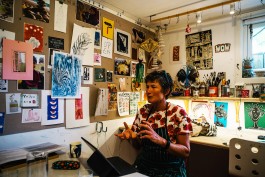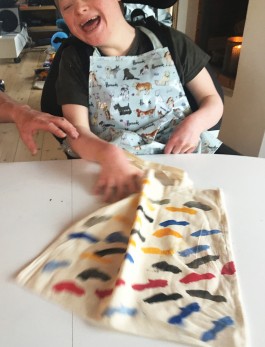Åpent verksted, “the open workshop”, is located in Røa, on the western edge of Oslo. Either in or outside of the studio, Emma Davis, through her artistic work, tackles social challenges, facilitates interaction between people from different backgrounds and boosts self-esteem within vulnerable groups, with a focus on exploring a variety of techniques while having fun.
Emma graduated as an architect from the University of Cape Town. She practiced architecture for 20 years before opening the workshop which, since 2016, has become her full-time occupation. “I had fun while I was working in a small firm in Oslo. Some projects were interesting, but I felt like I wasn’t making any meaningful contribution to people's lives. My favorite projects were the ones that had good interactions with the people I was working with. When I was a student, I always saw myself doing community projects, a dream I didn’t fulfill within architecture. I have always worked on various arts and printmaking projects in addition to architecture.”
Besides the private art classes that she offers in her workshop, Emma has been running art classes in asylum seekers centers all over Norway with various projects engaging mainly with young kids and women. Another project, Skap & snakk (Create & chat) is a pilot project based in Hovseter, a residential area consisting mainly of housing blocks from the 1950s-70s. There is a lot of social housing, and the area has become home to a growing community of people granted asylum, trying to adapt to their new lives. “It's a tough area with a lot of challenges - relatively high unemployment, physical and mental health challenges, quite a few kids and young people under state protection. In the summer holidays some kids stay nine weeks inside doing very little.” All this in the middle of a very affluent area of Oslo - it's quite a stark contrast. "This summer we ran a week of ‘summer school’ for kids - every day jam packed with creative projects. Some of the kids hadn’t been anywhere or done that much for weeks. They loved it!"
“Everyone can join the classes. No skills are needed to participate. I show different techniques and provide the materials and then we experiment with all kinds of things. Building things with words, with rubbish, painting with watercolor, drawing with wax crayons”, explains Emma. “For kids it is like a pleasure house and often the parents will stick their head in the door."
"We might not have a word of the same language, but everybody gets it. It's very moving. It is basically about giving kids space for imagination, to get wild and actually enjoy themselves."
"Kids have this amazing resilience, they might not know where they're going to be tomorrow or the next day, but they still can get into a project and have a lot of fun. On the other hand, grownups are more reserved" at least initially, she admits. “When I work with women it is also very nice and affirming but totally different. I suppose it's not that easy to let go and just have a good time. Adults are so much more inhibited. We sit around the table and have tea, chat and maybe paint a little bit or make a drawing or collage. Some of the women might live around the same square or the same building, but It feels that they need someone from outside to give them a push to start a conversation. I'm always wondering what is missing to create this interaction. So I enter the situation and bring my techniques and my artistic practice. I give them a little task and this mindless activity to paint or draw allows them to make contact. I think it is the shared experience that breaks the ice. We use the “making” as an tool to start a conversation. The outcome isn't important, it’s the process that I’m interested in. If you don't have any common cultural references, and often limited language, the discussion can run dry quite quickly. But when you have a task, it's much easier to open up than sitting in a circle trying to make conversation. Someone might start talking about their kids, where they buy a specific product and it all starts flowing much more easily. And then maybe one will ask for help filling out this or the other form. I think as soon as you start feeling like you belong a little bit, that changes the way you make connections.”
Emma grew up in South Africa so in a way she is also a stranger. “Of course you cannot compare the situation. I have many advantages, not least my mother tongue English, which many Norwegians can speak pretty fluently, and in some ways I could relate a little bit easier to the culture. If you are coming from somewhere completely different with no access to the language, it is incredibly isolating and I think many people feel that others are looking down on them... It's really tough. The workshops bring together women that have lived here most of their lives and women that have arrived more recently. For the first group it is often the case that they have never met somebody from Iraq or Afghanistan or Syria or Eritrea, and perhaps never really spoken to someone with a different skin color to themselves. But when both groups meet, they realize that we are all quite similar, and often want the same things in life."
"I had a very interesting experience a year ago when I was up in Northern Norway, also running a course in an asylum seekers center, in this tiny little town on an island. A local woman told me that she was so grateful for that center. She'd lived in that little town her whole life and up until she was 16 years old she thought the only herbs and spices were salt and pepper and then suddenly these people start coming from all over the world with their different culinary traditions, she said, she felt they were bringing the world to her. I think it is such a nice way of seeing things. To see people as a resource and as an enrichment to our communities. Integration is such a problematic term, it creates anxiety and stress, you know, you have to prove that you are good. Everybody needs to integrate to each other, and not just teach someone how they should behave, eat, dress etc.”
Emma's workshop is only half an hour away from the city center, but she admits that being located more centrally might make it easier to get in contact with more people. However, “Either in the center or here in the suburbs, i think my work can be of impact. I love what I’m doing and it's kind of disappointing that I never really did that in architecture, but I'm making up for it now. Since I cannot apply for funding as an individual, I often work under the umbrella of other initiatives. These collaborations help me apply what I’m doing to another scale. That's why I love working with MakersHub. Through building things they are empowering people. It's such a simple process, you have to trust people and give them some responsibility, then they feel like they own a bit of what they do and they have some ownership to the space they live in. It's not rocket science.”
Åpent verkstedt
Google maps: →
Website: apent-verksted.com
Project Links: Skap og snakk
Related: MakersHub















